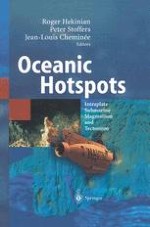2004 | OriginalPaper | Buchkapitel
The Foundation Chain: Inferring Hotspot-Plate Interaction from a Weak Seamount Trail
verfasst von : J. M. O’Connor, P. Stoffers, J. R. Wijbrans
Erschienen in: Oceanic Hotspots
Verlag: Springer Berlin Heidelberg
Enthalten in: Professional Book Archive
Aktivieren Sie unsere intelligente Suche, um passende Fachinhalte oder Patente zu finden.
Wählen Sie Textabschnitte aus um mit Künstlicher Intelligenz passenden Patente zu finden. powered by
Markieren Sie Textabschnitte, um KI-gestützt weitere passende Inhalte zu finden. powered by
The Foundation Chain was first detected using a combination of satellite altimetric and conventional geophysical data (Sandwell 1984, Mammerickx 1992) and described initially as a ∼1350 km long chain of seamounts trending approximately in the direction of the absolute motion of the Pacific Plate (Mammerickx 1992)Fig. 11.1. A significant section of the Foundation Chain lies in a tectonic setting influenced by a change in the direction of sea-floor spreading between 26 and 11 Ma (Herron 1972; Lonsdale 1988; Mayes et al. 1990; Mammerickx 1992). This motion change is reflected in the curvature of the Agassiz Fracture Zone (FZ) and its west-east shift in orientation between the Resolution/Del Cano and Chile FZs Fig. 11.2. A segment of the Nazca plate was transferred to the Pacific Plate during this period of reorganization to form the short-lived Selkirk Microplate Fig. 11.2 (Mammerickx 1992; Tebbens and Cande 1997; Tebbens et al. 1997) via a spreading-ridge propagation event between chron 6C (23.4–24 Ma) and Chron 6(0) (20.2 Ma) (Tebbens and Cande 1997).
